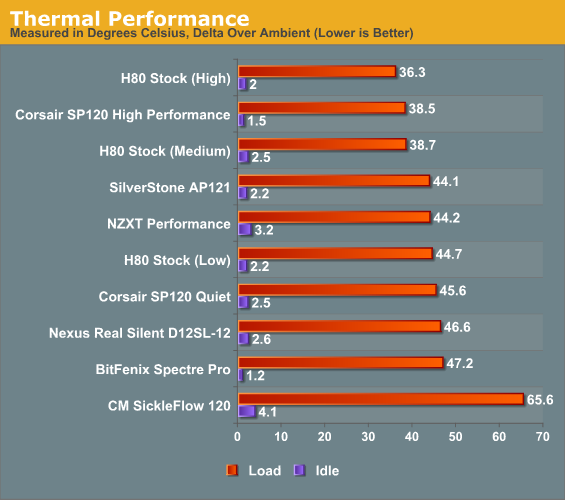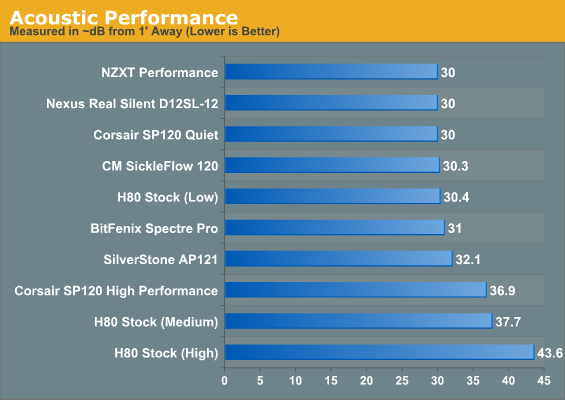Choosing the Best 120mm Radiator Fan: Testing Eight Fans with Corsair's H80
by Dustin Sklavos on August 23, 2012 12:01 AM ESTTest Results
Before we get into the performance results, a refresher: all eight fans on one chart for comparison. Note that if we're not taking noise into account, the highest static pressure fan should theoretically be the best performer. Our H80's fan settings are also only active with the stock fan; all others run at the full twelve volts.
| Fan | Airflow (in CFM) | Static Pressure (in mm/H2O) | RPM | Rated dBA |
| H80 Stock | 46-92 | 1.6-7.7 | 1300-2500 | 22-39 |
| SP120 Quiet |
37.85 |
1.29 | 1450 | 23 |
| SP120 High Performance | 62.74 | 3.1 | 2350 | 35 |
| SilverStone AP121 | 35.36 | 1.71 | 1500 | 22.4 |
| BitFenix Spectre Pro | 56.22 | 1.24 | 1200 | 18.9 |
| Nexus Real Silent D12SL-12 | 36.87 | 1.2 | 1000 | 18 |
| CoolerMaster SickleFlow 120 | 69.69 | 2.94 | 2000 | 19 |
| NZXT Performance | 47.27 | 0.95 | 1300 | 25.35 |
As far as static pressure goes, most of these fans are hanging out in about the same neighborhood. Acoustically, only Corsair's SP120 High Performance and stock H80 fan are even rated to go above the noise floor of our sound meter, though it's clear the stock fan is designed to move heat as fast as humanly possible. Let's see how all of these theoreticals worked out in practice, though.
Ambient temperatures ranged between 24C and 26C, and the margin for error in results is roughly 1C.

Thermally, if we ignore the H80's stock fan, the SickleFlow should've eaten the competition alive, but as it turns out CoolerMaster's specifications were more than just a little optimistic, as it was hands down the worst radiator fan we tested by a wide margin. If we organize the fans by rated static air pressure, they'd rank from best to worst: SP120 High Performance, SickleFlow 120, SilverStone AP121, SP120 Quiet, BitFenix Spectre Pro, Nexus Real Silent, and dead last, the NZXT Performance. As it turns out, though, only the SP120 High Performance really performs in line with its specifications; the rest just bunch up while the SickleFlow 120 is clearly the worst.
So how about acoustic performance?

Well, at least CoolerMaster's fan is quiet while it cooks your processor. To get that great thermal performance from the SP120 and H80 stock fan, though, you're going to have to put up with some noise. Note that these are load noise readings; the H80 stock fan idles at or below our sound meter's 30dB threshold at Low and Medium settings while sitting at 34.3 dB at High.
Interestingly enough, despite having among the worst rated specs, NZXT's Performance fan seems to find the best balance between thermal performance and acoustics; Corsair's SP120 Quiet does little to justify itself over the stock H80 fan. Corsair's engineers also turned out to be mostly right on the money: the H80 stock fan by and large seems to be the best choice, at least for the H80 itself. Its Low setting is competitive with the other fans both thermally and acoustically, while its Medium setting is competitive with the SP120 High Performance fan. The High setting is essentially unnecessary.










113 Comments
View All Comments
Zap - Friday, August 24, 2012 - link
IMO the most important revelation of this review/roundup is:LOUDER = BETTER COOLING
All else being equal, that is a fundamental fact that cannot be avoided. Sure you can push results one way or another with smart fan choice, but the fact remains that higher airflow (with static pressure, when used with restrictive rads) makes for better cooling as well as higher noise.
BlueReason - Friday, August 24, 2012 - link
"What may be most disappointing about this lineup, though, is the unfortunate fact that there may be no magic bullet radiator fan that's able to produce stellar thermals with low noise."With all due respect... You tested six fans. Six. The Corsairs count as one, Captain Fan Control. Worse yet, only one of the models was actually designed for heatsink application, in a market where there are numerous others.
Oh yeah, the Silverstone's spiral grill is designed to PROJECT AIR ACROSS A DISTANCE. It's a case intake fan. C'mon.
Love ya, Dustin. Really. Do some research, gather some appropriate fans designed for or at least with a strong reputation for hsf use, and ask around about modern test methodology. Fan reviewing is a pain, I know. There's no convenient benchmark program for it. Here's one tip: Get access to a LongWin machine. If Linus at NCIX can get to one (http://www.youtube.com/watch?v=9uUXt7mE6Qg&fea... so can the web's preeminent computing site (that's you guys, bro). If you want credible fan analysis, you need data from professional equipment meant for it, not "Grandma's Blog" style guesswork.
Yes, fans matter, a lot; a fact that is being increasingly recognized. Thanks for getting on board. =)
vectorm12 - Friday, August 24, 2012 - link
As many have already pointed out I would really have liked to see some of Noctua's fans in the roundup as well as a couple of the Be Quiet! fans which at least on paper look pretty good. From a price perspective they seem to be in the same league as Noctua.DustoMan - Friday, August 24, 2012 - link
Thank you for doing this roundup. When corsair came out with those fans, I through about swapping out the stock fans on my H80. Now I know to just save the time and money!MeanBruce - Friday, August 24, 2012 - link
Anyone that is using the NF-F12s with the LNAs 12v drop down inline attenuators is completely missing the entire boat here.The NF-F12s are PWM fans, in PWM mode with a PWM fan controller either outboard or installed, will run a full range of 1200rpm way down to an inaudible to the human ear 300rpm or any other thermal/rpm profile the user wishes it to be.
Do some homework, then trial and error before posting, and Anand not including these fans is outrageous. Why come here.
1200rpm – 300 rpm. Mix it up and love your rig much more.
Get them airbrushed RED and BLACK, to avoid the hidden brown ad nauseam.
This just in from Noctua:
“The best way to adjust the speed of your pwm fans will be to either connect them to a 4pin mainboard fan header or to use an external fan speed controller that supports 4pin pwm fans. Because while it is possible to reduce the fan speed by lowering the voltage, only using them in pwm mode will allow you to get the fan speed as low as 300rpm.”
Kind regards,
Alexander Dyszewski
Noctua support team
“I'm sorry, but I can't recommend you a specific fan controller.
However it might be possible to use multiple splitters (included with the fans) to connect your 3 fans to one channel/controller. Our NF-F12 fan is rated at 0,05A or 0,6W, which is quite low compared to other fans and therefore the fan controller should be able to handle 3 fans with in total 0,15A or 1,8W; but please check this with the fan controller specs or manual to be on the safe side.”
Kind regards,
Alexander Dyszewski
Noctua support team
“At 300rpms for the NF-F12s, 6 to 8dB sounds about right, we didn't publish the values for minimum fan speed, because it gets difficult to make reliable measurements at such low noise levels. In real world terms the NF-F12 is inaudible when spinning at minimum fan speed.”
Kind regards,
Alexander Dyszewski
Noctua support team
freespace303 - Saturday, August 25, 2012 - link
These articles is why this site is on my favorites bar. Thank you!Capt Proton - Saturday, August 25, 2012 - link
I finf this review unworthy of the usually high standards Anandtech has represented to me. Not including such obvious choices as Gentle Typhoons and Noctua's is an extremely puzzling choice. If one follows threads on fans for either air or water cooling, it is obvious that the Gentle Typhoon's are certainly one of the most popular. Not to include them opens the possibility of a hidden agenda, though I am not sure what that may be.random2 - Saturday, August 25, 2012 - link
It always amazes me when I see reviewers overlook very good and very popular products. Yes, I'm another damned Noctua fan. No pun intended. :-)n13L5 - Sunday, August 26, 2012 - link
Its a very small selection of fans to start... fans are cheap, could have really gotten some more, including the Noctua, Alpenfoehn, Thermalright, Noiseblocker, Phanteks, Papst, BeQuiet, Xilence...And then, why oh why are you calling 30 dB your noise floor???
In my room, which has some sound damping, but is still far from an anechoic chamber, I've measured down to ~10 dB.
When people set up their systems with enough fans and well tuned automated fan control, they can get a gaming system that's below 15 dB during office work and still stays around 20 dB during gaming, given the right GPU choice, like Gigabyte's 3 fan OC Windforce series.
flowrush - Thursday, August 30, 2012 - link
Would also liked to have seen my lovely Silent Eagle by Sharkoon. Dimples ftw!